I am trying to use some sort of draw method to draw a sprite image to my subclass of JPanel called AnimationPanel. I have created a Spritesheet class which can generate a BufferedImage[] that contains all of the sprites in the sheet. In my AnimationPanel class, which implements Runnable, I am getting that BufferedImage[] from the spritesheet instantiated in the AnimationPanel constructor. I want to be able to loop through this array and display each sprite to the screen. How would I do this? Here are my AnimationPanel and Spritesheet classes.
AnimationPanel
package com.kahl.animation;
import javax.swing.JPanel;
public class AnimationPanel extends JPanel implements Runnable {
//Instance Variables
private Spritesheet sheet;
private int currentFrame;
private Thread animationThread;
private BufferedImage image;
public AnimationPanel(Spritesheet aSheet) {
super();
sheet = aSheet;
setPreferredSize(new Dimension(128,128));
setFocusable(true);
requestFocus();
}
public void run() {
BufferedImage[] frames = sheet.getAllSprites();
currentFrame = 0;
while (true) {
frames[currentFrame].draw(); //some implementation still necessary here
currentFrame++;
if (currentFrame >= frames.length) {
currentFrame = 0;
}
}
}
public void addNotify() {
super.addNotify();
if (animationThread == null) {
animationThread = new Thread(this);
animationThread.start();
}
}
}
Spritesheet
package com.kahl.animation;
import java.awt.image.BufferedImage;
import java.imageio.ImageIO;
import java.io.IOException;
import java.io.File;
public class Spritesheet {
//Instance Variables
private String path;
private int frameWidth;
private int frameHeight;
private int framesPerRow;
private int frames;
private BufferedImage sheet = null;
//Constructors
public Spritesheet(String aPath,int width,int height,int fpr, int numOfFrames) {
path = aPath;
frameWidth = width;
frameHeight = height;
framesPerRow = fpr;
frames = numOfFrames;
try {
sheet = ImageIO.read(getClass().getResourceAsStream());
} catch (IOException e) {
e.printStackTrace();
}
}
//Methods
public int getHeight() {
return frameWidth;
}
public int getWidth() {
return frameWidth;
}
public int getFramesPerRow() {
return framesPerRow;
}
private BufferedImage getSprite(int x, int y, int h, int w) {
BufferedImage sprite = sheet.getSubimage(x,y,h,w);
}
public BufferedImage[] getAllSprites() {
BufferedImage[] sprites = new BufferedImage[frames];
int y = 0;
for (int i = 0; i < frames; i++) {
x = i * frameWidth;
currentSprite = sheet.getSprite(x,y,frameHeight,frameWidth);
sprites.add(currentSprite);
}
return sprites;
}
}
